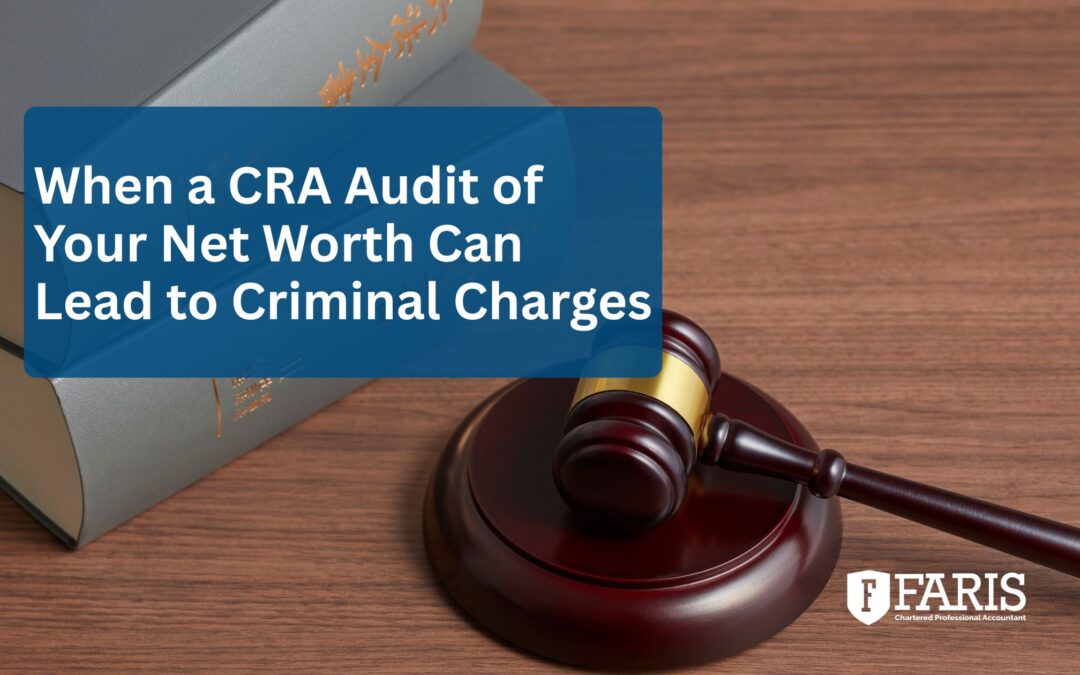The average person might assume a CRA audit begins with a single issue, an overstated deduction, a late return, or missing receipts. Many audits start quietly, however, triggered by data analytics, lifestyle discrepancies, or financial patterns that don’t add up. Once that process begins, the CRA has the tools and authority to look far beyond a taxpayer’s returns, reconstructing their financial life through indirect means.
It’s a process that can feel deeply personal because it reaches into how someone earns, spends, and saves. The CRA collects this data from several sources, including bank transactions, municipal property records, postal code information, and social media posts. For business owners, professionals, and investors alike, understanding how the CRA approaches net worth audits and investigations can make the difference between a manageable review and a far more serious situation.
Indirect Verification of Income
CRA auditors don’t rely solely on filed returns to confirm a person’s income. When something doesn’t align, such as lifestyle spending or assets that far exceed declared income, they often turn to indirect income verification methods. These tools use financial and lifestyle indicators to help the CRA estimate a taxpayer’s actual income instead of what’s reported in their return.
The Net Worth Approach
A common method is where auditors compare a taxpayer’s assets and liabilities at two points in time. The increase in net worth, adjusted for living expenses and non-taxable income, can reveal unreported earnings. For example, if a taxpayer’s investments and property holdings increase by $500,000 in one year, yet their declared income is $75,000, the CRA will likely ask where the difference came from.
Other Tests & Analyses
Auditors also use bank deposit analyses, source and application of funds tests, and cash expenditure methods to spot inconsistencies. These are often aided by computer-assisted audit techniques (CAATs), which allow CRA analysts to cross-reference financial data, such as banking records, T5 slips, or third-party transaction reports, to identify red flags or hidden income sources.
How CRA Chooses Taxpayers for a Net Worth Audit
These tools flag patterns inconsistent with industry norms, unexplained asset growth, or large discrepancies between reported and observable financial activity. In other words, in most cases, a net worth or tax audit isn’t random; it’s triggered by data analytics, lifestyle indicators, or tips from informants, all designed to reveal income that doesn’t match the numbers filed on a tax return.
CRA’s Net Worth Assessment Technique Used in Audits
The net worth assessment technique is not designed for routine tax audits. It focuses on what can be proven through assets, liabilities, and spending patterns. Once discrepancies have been identified and a taxpayer is selected for a net worth audit, auditors expect the taxpayer to justify any discrepancies through legitimate, verifiable sources such as savings, gifts, or inheritances.
This technique is especially common in cases where a person’s records are incomplete, unreliable, or inconsistent with their lifestyle, such as business owners who deal heavily in cash or individuals with complex asset holdings or foreign income sources.

Data Collection and Reconciliation
Before performing calculations, CRA auditors gather extensive data. They review bank and investment statements, real estate records, vehicle ownership, and loan documents. They also examine lifestyle indicators such as travel, renovations, and high-value purchases.
Once collected, auditors reconcile this information against the taxpayer’s declared income and liabilities. Every asset, down to furniture, vehicles, and even cryptocurrency holdings (learn more about crypto tax in Canada), is valued as of the audit’s start and end dates. Liabilities, such as mortgages and credit card balances, are deducted to establish a clearer financial picture.
This process allows the CRA to build an independent financial profile of the taxpayer. When the reconstructed income differs significantly from what’s been reported, auditors pursue explanations supported by documentation.
Assessment of Unidentified Deposits and Projections
Unidentified or unexplained bank deposits are one of the first red flags in a net worth audit. CRA analysts routinely compare all inflows to a taxpayer’s declared income and known non-taxable sources. If deposits appear without explanation, the CRA presumes they represent unreported income unless the taxpayer can prove otherwise.
For example, multiple $10,000 cash deposits over several months without supporting loan documents or gift letters would likely be considered taxable income. Auditors will also use projection techniques when full records aren’t available. They may analyze a representative period, such as a few months of bank activity, and extrapolate income patterns over the entire tax audit year.
This is common in cases involving informal cash transactions or missing records. While the CRA is expected to use reasonable estimates, their projections can result in significant assessed income increases, which can only later be overturned if the taxpayer provides credible evidence and documentation.
Audit of Non-Taxable Sources of Funds
A key step in every net worth assessment is identifying which inflows are non-taxable. Not all increases in wealth come from income: some come from sources like gifts, loans, inheritances, or lottery winnings.
CRA tax auditors require documentation to verify these claims. For gifts, they look for signed letters from donors, evidence of the donor’s financial ability to provide the funds, and bank records confirming the transfer. For loans, the CRA expects formal loan agreements, repayment schedules, and proof of deposits or withdrawals consistent with the loan’s terms.
Inheritances are verified through estate documents, such as wills or executor correspondence, while lottery winnings or other windfalls are checked against provincial lottery databases or official statements. If a taxpayer can’t substantiate that funds came from a non-taxable source, auditors will likely treat the amount as unreported income.
This process can feel intrusive, but it reflects the CRA’s mandate to confirm that every dollar of wealth increase has a legitimate and traceable origin.
When the CRA Uses the Net Worth Technique
High-risk industries such as construction, hospitality, or personal services, where cash transactions are frequent, are often subject to this form of tax audit. The technique is also common in investigations triggered by informants, related-party discrepancies, or data analytics suggesting underreporting.
While the CRA calls it an “indirect verification of income,” the consequences can be direct and severe. A significant unexplained increase in net worth can lead to reassessments, civil penalties, or, in extreme cases, criminal investigations for tax evasion.

Implications for Taxpayers
For taxpayers, a net worth audit is both a financial and procedural test. The CRA’s findings are presumed accurate unless effectively rebutted. That means it’s not enough to argue that the auditor’s assumptions are unfair; the taxpayer must provide documentation that demonstrates alternative explanations.
Professional help from a tax accountant specializing in CRA disputes (like our team at Faris CPA) is essential during these types of tax audits. Our experienced tax advisors and forensic accountants identify where the CRA’s calculations may rely on flawed data or double-counted assets. In many cases, our properly substantiated responses have reduced or eliminated large reassessed income amounts before they escalated into allegations of willful misrepresentation.
Penalties and Offences Related to CRA Net Worth Audits
A CRA net worth audit can expose more than just unreported income; it can trigger a range of civil penalties and, in serious cases, criminal prosecution. The penalties vary in scope and severity depending on whether the CRA concludes that the taxpayer’s errors were careless, negligent, or deliberate. The legislative authority for most of these penalties is found under the Income Tax Act (ITA) and the Excise Tax Act, which give the CRA wide discretion to assess additional taxes, interest, and penalties when income has been understated or omitted.
Civil Penalties and Their Legislative Basis
Civil penalties are the most common outcome of a net worth audit. They are applied when the CRA determines that a taxpayer has made false statements, omitted income, or failed to maintain adequate books and records. Under section 163(2) of the ITA, a gross negligence penalty may be imposed if the taxpayer knowingly, or under circumstances amounting to gross negligence, made a false statement or omission in their tax return.
The penalty is typically 50% of the understated tax or the overstated credits, whichever is greater. For example, if a taxpayer underreports $200,000 in income leading to $60,000 in unpaid tax, the CRA may impose an additional $30,000 penalty on top of the tax and accrued interest.
Penalties can also be assessed under section 162 for repeated failures to file returns, late filings, or non-compliance with tax audit requests. In those cases, the amounts are smaller but can accumulate quickly if the taxpayer ignores repeated CRA demands.
Application of Penalties for False Statements or Omissions
When determining whether to apply penalties for false statements or omissions, the CRA evaluates both intent and conduct. Gross negligence implies more than simple carelessness; it suggests indifference to accuracy or a willful disregard for tax obligations.
To justify a penalty, the CRA must show that the taxpayer made a false statement knowingly or in circumstances amounting to gross negligence. The burden of proof rests initially with the CRA to prove intent or willful disregard. However, once a discrepancy is established, such as through a net worth assessment, the burden often shifts to the taxpayer to provide credible evidence explaining the difference, and their response is crucial.
The penalty amount is calculated as a percentage of the tax avoided. CRA auditors also consider factors such as:
- The magnitude and frequency of errors or omissions.
- Whether the taxpayer cooperated with the audit.
- The completeness and reliability of records.
- Any prior compliance history or warnings.
Taxpayers who voluntarily disclose unreported income before the audit begins may avoid penalties entirely and under the Voluntary Disclosures Program (VDP). Once a tax audit starts, however, the opportunity for relief generally disappears.

Criminal Charges & Legal Consequences
While civil penalties are common, criminal charges are reserved for more serious cases, those involving deliberate deception, falsified records, or significant tax evasion. The CRA’s Criminal Investigations Program (CIP) investigates such cases, often after a civil audit reveals evidence suggesting intentional misconduct.
Criminal offences under the Income Tax Act fall into three categories:
- Summary offences, which are less serious and usually prosecuted in provincial court. Conviction may result in fines up to 50% of the tax evaded, imprisonment for up to two years, or both.
- Indictable offences, which involve substantial tax evasion, forged documents, or organized schemes. Convictions can lead to fines of 100%–200% of the tax evaded and imprisonment for up to five years.
- Hybrid offences, where the Crown may elect to proceed summarily or by indictment depending on the gravity of the case and the amount involved.
Convictions are publicly reported, and the CRA routinely issues press releases identifying taxpayers found guilty of tax evasion. These cases often carry reputational damage far beyond the financial penalties, affecting business relationships and professional standing.
Criminal prosecutions differ fundamentally from tax audits: the standard of proof is much higher, beyond a reasonable doubt, and the process involves the Public Prosecution Service of Canada (PPSC), not CRA auditors. Taxpayers under investigation have rights under the Canadian Charter of Rights and Freedoms, including protection against self-incrimination and unreasonable search and seizure.
Failure to Maintain Adequate Records
A recurring issue in net worth audits is the failure to maintain proper financial records. Under section 230 of the ITA, taxpayers are legally required to keep adequate books and records supporting the information in their returns. Failure to do so can lead to penalties under section 238, which carries fines up to $25,000 and potential imprisonment for up to 12 months.
Even when poor recordkeeping isn’t deliberate, it increases the risk of arbitrary assessments. In such cases, the CRA’s estimates are presumed accurate unless the taxpayer can disprove them, a difficult task without convincing documentation.
Repeated Non-Compliance and Escalating Sanctions
Persistent non-compliance can compound the problem. Repeated failures to respond to CRA requests, ignoring reassessments, or refusing to produce documents may lead to enforcement actions such as garnishments, asset seizures, or liens. In certain cases, the CRA may pursue directors or spouses under joint liability provisions if they benefited from unreported income.
When auditors believe there’s a deliberate pattern of evasion, such as multiple years of omitted income, use of nominees, or offshore accounts, the case may be escalated for criminal investigation. That transition often marks the point where the file moves from administrative audit to potential prosecution.

Due Diligence and Relief Provisions
Taxpayers are expected to exercise due diligence in maintaining accurate records, filing returns on time, and ensuring that all sources of income are properly reported. The CRA interprets due diligence as the reasonable care a prudent person would take in managing their tax affairs. This means keeping supporting documentation for income and expenses, reconciling bank deposits, and consulting qualified professionals when tax issues become complex.
However, the Income Tax Act gives the CRA discretion to grant relief when circumstances justify it. Under the Taxpayer Relief Provisions in subsection 220(3.1), the CRA may cancel or waive penalties and interest if the taxpayer can demonstrate that non-compliance arose from circumstances beyond their control, such as serious illness, financial hardship, natural disasters, or CRA processing delays. Relief can also be considered when the taxpayer made a genuine error despite exercising reasonable care/due diligence.
Requests for relief must be supported by documentation and filed within ten years of the end of the relevant tax year. The CRA evaluates each case on its merits, considering the taxpayer’s history, conduct, and efforts to rectify the issue.
Wrapping Up
How well your records hold up often determines how far the CRA will dig. One overlooked but critical task is proactive documentation: keeping written explanations for major transactions, large cash infusions, or asset purchases before questions ever arise.
Doing so helps establish transparency if your financial story is ever challenged. If you’ve already been contacted, or suspect your finances could attract attention, professional guidance can help you respond strategically and protect your position. Contact Faris CPA for experienced net worth and tax audit representation, and practical solutions that keep small issues from becoming serious tax problems.




